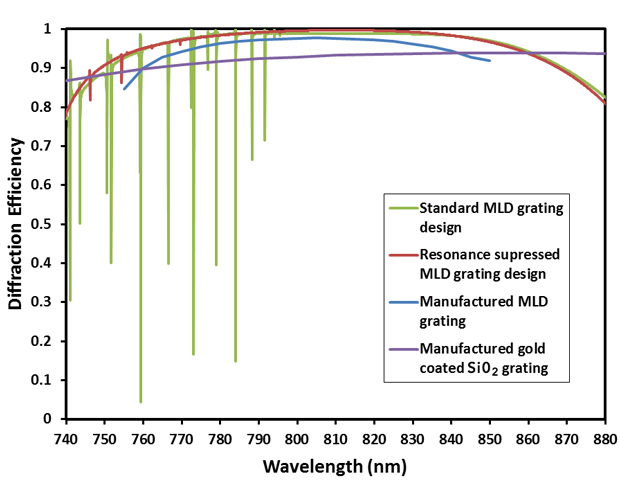Leon Haefner (14-ERD-084)
Abstract
For over 15 years, the Laboratory has been a leader in the design, development, and fabrication of meter-scale diffraction gratings used to stretch or compress pulses to modify laser energy for femtosecond laser systems. The gratings are key to achieve high laser irradiance and are used in short-pulse compressors in a scheme referred to as chirped pulse amplification. High-average-power ultrafast lasers are required for machining or driving high-flux secondary sources such as coherent or incoherent x-ray generation and particle accelerators. However, new laser capabilities require new gratings. The main challenge in operating at high average power is thermal management in the laser amplifiers and control and mitigation of thermally induced distortions in the diffractive pulse-compression gratings. We plan to develop new pulse-compression gratings to enable high average power (>100 W) and enhance existing systems by up to 25%. We intend to (1) develop and engineer the process for fabricating broadband, metallic gratings capable of operating at 300-W average power; (2) understand the impact on short-pulse laser performance of deposited heat in large-area gratings and implement active heat removal; (3) explore and develop a nonplanar laser pulse-compressor design; (4) design and develop high-average-power, high-efficiency, nonplanar, multiple-layer dielectric diffraction gratings supporting 30-fs pulses or better; and (5) construct a test laser.
If successful, we will design, develop, and demonstrate actively cooled, metallic gratings capable of the shortest pulse compression of femtoseconds at high average power greater than 300 W (a tenfold increase in average power capability), as well as high-efficiency multilayer dielectric gratings capable of short-pulse compression greater than 30 fs with very high efficiency. We will develop an understanding of the impact on short-pulse laser performance of deposited heat in large-area gratings and implement active heat removal. Our new designs will enable energetic high-average-power ultrafast lasers and improve the compressor efficiency up to 25%. Success will also enhance the Laboratory's grating manufacturing capabilities and provide numerous opportunities for collaboration with external high-energy petawatt laser projects. It will further pave the path to the next generation of ultrahigh-repetition-rate ultrafast laser systems employing diode-pumped solid-state lasers.
Mission Relevance
High-average-power, ultrafast lasers are highly relevant to defense, homeland security, fundamental science, biological, and medical applications because of their compactness, high brilliance, and potentially lower cost than conventional sources. Ultrafast laser drivers require a new generation of diffractive optics that can withstand high average power and actively manage residual heat. Our work addresses these challenges and will enable high-average-power, short-pulse laser operations never before achieved, in support of the Laboratory's core competency in lasers and optical science and technology.
FY15 Accomplishments and Results
In FY15 we (1) demonstrated the capability to model the electric field distribution within the multilayer diffraction grating; (2) utilized this modeling capability to understand guided-mode resonances occurring in broadband, multilayer dielectric diffraction gratings; (3) developed a design for a broadband multilayer diffraction grating with suppressed guided-mode resonances; (4) designed and simulated an out-of-plane, short-pulse compressor with gratings operating at an incidence angle that matches the diffraction angle (in a special geometry called the Littrow configuration); and (5) modeled the active cooling of average-power gratings






